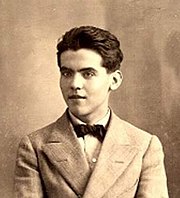Federico García Lorca's Human Design Chart
5/1 Emotional ProjectorSpanish writer, a poet and playwright. Unusual looking, he had large, dreamy eyes and a big head, a clumsy body, flat feet and a rigid walk which he bemoaned, “Oh my clumsy walk!” He was afraid of crossing streets because he could not run should a speeding car approach.
The son of a wealthy landowner of Andalucia and a former school teacher, García Lorca lived happily in the Andalucian countryside. He loved being close to nature, which had a great influence in his future poems, before his family moved to Granada.
From childhood, he showed talent in music, writing and drawing. He was not a very successful student and was loathed by some uptight teachers, though praised by the teachers who recognized his talent. His great musical skill gave him the confidence to study piano with the goal of playing on the concert stage. Due to his father’s objection, he was forced to take a law degree instead, in Madrid.
As a student, he lived in a university hostel. Highly popular, his friends leaned toward intellectuals and artists, including Luis Bunuel, Salvador Dali (with whom he had an ill-fated love affair) and Rafael Alberti. During 1929-30, he visited the American east coast and New York City, where he witnessed the Wall Street Crash. His visit resulted in his volume, “A Poet in New York.” He concluded his journey with a visit to Cuba, where he was well received and had a happy time.
A supporter of the Spanish Republic, García Lorca founded a university theater company, “La Barraca” in 1930-32. Subsidized by the government, the company traveled throughout the Spanish villages and towns, performing the classics to the local people free of charge. In 1933-34, García Lorca was triumphantly received in Argentina, gaining commercial success with his plays and earning an affluent position. In 1934-35, he repeated his success in Spain in spite of right-wing dissidents who criticized him severely, calling him a “Jewish-Marxist” and an “atheist.”
On 14 July 1936, shortly before the outbreak of the Spanish Civil War, García Lorca stayed in his home town in Granada. On 9 August 1936, his presence was noted by the Nationalists (Spanish fascists) who began to search for him. Being a Republican supporter, a successful “subversive” poet and playwright and the son of a Republican liberal landowner, García Lorca was deeply loathed by the ultra-conservative and envious bourgeoisie of Granada. Physically clumsy and inept, he took refuge in the home of Luis Rosales, a Falangist poet friend. He was captured there and arrested on 16 August 1936 and charged by Ramon Ruiz Alonso, an ex-MP and a friend of Lorca’s father’s enemies, of being “a subversive writer, a Russian spy, a friend of minister Fernando de los Rios and a homosexual.”
In spite of appeals made by his Falangist friends, García Lorca was shot down in the early hours (about 4:45 AM) of 18 August 1936* in Puente Grande, near Granada, along with a Republican school-teacher and two anarchist bull-fighters. Wounded and suffering, according to his biographer, tortured, García Lorca was given medication for ease until he died of a final gunshot. It is claimed that Juan Luis Trescastro Medina fatally shot him. His body was never found and supposedly lies buried in a mass grave by a nearby hill along with 4,000 other victims of the Nationalists. García Lorca had long held a premonition about his tragic death.
(*Given as the 19th by his biographer, Ian Gibson.)
Link to Wikipedia biography
Discover More Famous People
Browse and analyze over 55,000 public figures and celebrities.
Ra Uru Hu
5/1 Manifestor
Martha Stewart
4/6 Manifestor
David Lynch
4/6 Generator
Barack Obama
6/2 Projector
Steve Jobs
6/3 Generator
Vladimir Putin
5/1 Manifestor
Kim Kardashian
3/5 Generator
Michael Jackson
1/3 Projector
Marilyn Monroe
6/2 Projector
Ariana Grande
2/4 Projector
Oprah Winfrey
2/4 Generator
Johnny Depp
2/4 ManifestorWhat is HumanDesign.ai and how does it work?
Curious what makes Federico García Lorca tick? HumanDesign.ai instantly maps their exact birth data into a fully interactive clickable bodygraph chart, letting you hover or tap every center, channel, and gate for plain-language explanations. Bella, the platform’s built-in AI guide, adds context in real time, translating complex mechanics into everyday insights so you can see how Federico García Lorca’s strengths, challenges, and life themes play out on-screen.
The same tools are waiting for you. Generate your own Human Design Chart in seconds, open a library of 2000+ suggested questions, and chat with Bella as often as you like to decode your design, daily transits, and even relationship dynamics.
Want to compare energies? Save unlimited charts for friends, family, or clients, then ask Bella to reveal compatibilities, composite patterns, or coaching tips, all in one conversation thread.
Start free with core features, or unlock our Personal and Pro plans for deeper dives: unlimited Q&A, celebrity chart search spanning 55,000+ public figures, white-label PDF reports, branded content generation, and a professional profile with built-in booking for practitioners. Whether you’re exploring your own potential or guiding others, HumanDesign.ai delivers an ever-expanding toolbox of AI-powered insights—no spreadsheets, no jargon, just clarity at your fingertips.
Ready to see yours? Signup for FREE today!

